Table of Contents
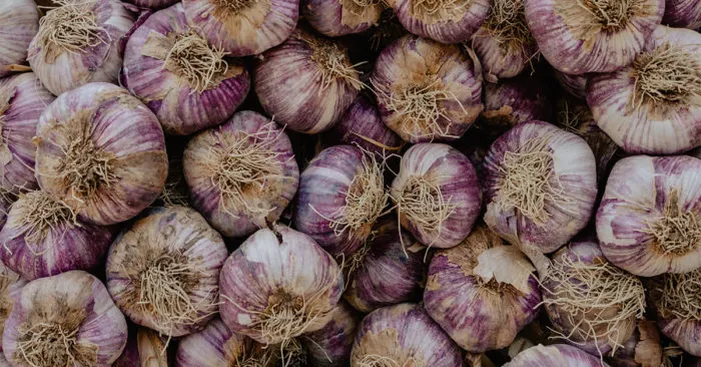
Red garlic: overview
Red garlic is among the Allium family and belongs to the genus Alliaceae. (1)
Throughout the centuries, garlic has been used for its dietary and medicinal properties.
Also, garlic has a unique smell and flavor mostly thanks to its content in a compound called Allicin. (2)
However, there are many different types of garlic with over 700 species ranked in two categories: hardneck and softneck garlic. (3)
Softneck garlic thrives in warmer regions, while hardneck is more suited for colder climates.
Today, we’re going to talk about one of the hardneck types: red garlic.
Red garlic mainly comes from the Republic of Georgia and goes by the name “Chesnok red garlic”. (4)
Although, there are other types of garlic that are red, the most widely known are the ones that come from the previous USSR region.
Botanically, red garlic is refered to as Allium Ampeloprasum, however, to avoid forgetting these technical names, you can simply refer to red garlic as “Russian garlic”. (5)
Difference between white and red garlic:

This is a very interesting thing to ask: does the color difference affect garlic on a nutritional level?
In fact, garlic contains the same nutrients no matter what color they are.
But, the color difference has an effect on the proportions of these nutrients.
Just like dates, they are all very nutritious with the same content and in different proportions of nutrients depending on the type.
You can actually notice the difference between two types of dates just by tasting, some would taste sugary and others are less sweet.
This same rule applies to garlic, which is why red garlic has a milder flavor and a sweeter taste compared to white garlic. (6)
It is completely unreliable to compare garlic types based on their benefits as all garlic is beneficial.
However, the importance is that the growing methods should be natural without any added chemicals such as fertilizers …
Characteristics of red garlic:

Red garlic is not very different from white garlic.
It is true there are many types of garlic that do have a certain type of redness in their peels.
Although, when you say “red garlic” usually it is referring to the “Chesnok garlic” or simply the “Russian garlic”.
This is because it was Russian immigrants who first introduced this type of garlic to North America back in the 1900s. (7)
Red garlic gained this popular name due to the purple stripes on its outer coating.
This is due to the existence of anthocyanin, a plant pigment that turns purplish in an acidic environment. (8)
Being grown in the colder Eastern part of the world, red garlic evolved to adapt to more acidic soils and survive during harsh winters.
Also, the existence of bigger quantities of anthocyanin compared to white garlic makes red garlic have additional benefits.
As for its size, red garlic looks like a larger version of classic garlic.
Each bulb contains 6 to 8 cloves and each clove can reach the size of a whole white garlic bulb. (9)
During spring, it blooms pink flowers unlike the usual white flowers normal garlic plants produce.
Also, the stems and leaves of red garlic are edible and can replace green onion and leek.
Benefits and nutritional values of red garlic:
Nutritional values of red garlic:
These data counts for an average red garlic bulb that weighs about 4 ounces (113g) and it contains: (10)

- Calorie: 148
- Fibers: 5.3g
- Fats: 0.38g
- Carbs: 24g
- Protein: 6.4g
- C vitamin: 26%
- B1 vitamin: 20.5%
- B5 vitamin: 11.5%
- B6 vitamin: 160%
- B9 vitamin 28.5%
- Potassium: 22.5%
- Calcium: 11.3%
- Zinc: 13.2%
- Copper: 34%
- Phosphorus: 25%
- Magnesium: 7.45%
- Iron: 13%
- Manganese: 96%
- Selenium: 3%
- Polyphenols: 5%
Benefits of red garlic:
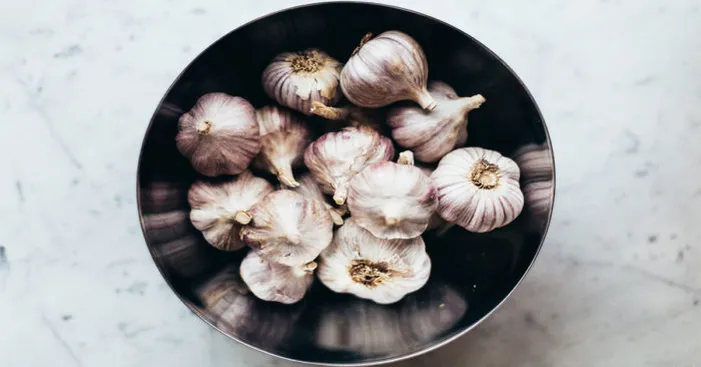
Red garlic belongs to the same family as white garlic and onion.
It has the same benefits as any vegetable in the Allium family with an additional virtue due to its color.
Fights fungal infections:
Due to its abundance of antioxidants, garlic is very beneficial in case of a fungal infection.
Fungal infections can be caused by different types of activities we do daily.
For instance, athletes, workers and people who wear shoes for a long period every day may get an “athlete’s foot” fungal infection. (11)
This happens when feet become very sweaty and yet confined in shoes.
It can cause annoying problems ranging from rash to itching and even burning.
In that case, you can blend peeled red garlic and use it as an ajoene-based lotion. (12)
Great antimicrobial properties:
Since ancient times, garlic has been known for its antimicrobial and anti-infection properties.
Particularly, it can show magical healing properties against bronchitis, colds, and other seasonal infections. (13)
If you have an itchy throat or cough randomly, try chewing on a clove of garlic.
Even though it may be a bit spicy, you’ll notice a huge difference when you wake up in the morning.
The little cloves of red garlic are a precious ally in winter to keep viruses away until the sun comes out.
Promotes cardiovascular health:
Red garlic, just like garlic and onion, contains allicin which is a natural compound that can decrease bad cholesterol in the blood.
Also, red garlic is a good source of adenosine, a natural compound that has a vasodilator effect. (14)
That means it can dilate blood vessels to ensure better blood circulation and this can explain the anti-hypertension effect of garlic.
In addition, red garlic is rich in prostaglandins, lipids that have the property of thinning the blood.
According to the WHO, garlic is full of natural compounds that can reduce atherosclerotic plaques. (15)
These types of plaques are a result of many years of deposition of cholesterol on the walls of the arteries.
Unfortunately, that makes arteries more rigid and reduces their diameters, therefore a huge factor of risk for cardiovascular diseases.
Nonetheless, people who consume garlic regularly show three times less risk of cardiovascular complications. (16)
Together, allicin, adenosine, prostaglandins and natural compounds make garlic beneficial for heart health.
May protect from cancer:
The compound responsible for the unique taste and smell of garlic is allicin which is full of sulfur content.
These sulfur compounds prevent the spread of cancerous cells and protect the body from potential carcinogens. (17)
Also, the many other antioxidants in garlic protect the cells from the harmful action of free radicals.
Those free radicals are the origin of most diseases specifically certain cancers (mostly stomach and intestine).
Neurodegenerative diseases:
The university of Louisville-USA conducted a study in which it shows that garlic could be an excellent solution to preserve cognitive ability and memory. (18)
When you consume garlic, it starts renewing the intestinal microbiota, which is the microflora directly connected to the brain through a network of nerves. (19)
Another words, it is the sulfur compounds in garlic that are responsible for the beneficial effect on memory.
Unique benefits of red garlic:

In this part, we focused on the health benefits caused by the abundance of anthocyanins in red garlic.
Anthocyanins are colorful organic compounds water-soluble that exist in all the purplish vegetables and fruits.
These plant components are flavonoids (flavylium to be exact) which is why they are considered good antioxidants. (20)
These are some of the health benefits of anthocyanin in red garlic: (21)
- Fights aging
- Protects the heart
- Helps to lose weight
- Reduces risks of cancer
- Prevents UTIs
Other benefits found in red garlic:

Due to the large number of health benefits of garlic, it is very hard to sum all of them in detail.
Here we list 18 health benefits you can get by eating just 1 clove of red garlic a day: (22)
- Reduces high blood pressure.
- It increases appetite.
- Stimulates blood circulation.
- Increases the body’s resistance to allergies.
- Reduces the risk of strokes.
- Eliminates microbes, pathogens, and germs.
- Delays the process of aging.
- Can treat injuries or insect bites and speed up healing.
- Improves the metabolism of iron in the body.
- Strengthens hair follicles and prevents hair loss (garlic oil or hair mask)
- An important source of sulfur and selenium.
- Calms the nerves.
- Stimulates fat burning and promotes weight loss.
- Purifies the liver from toxins.
- Expels intestinal worms.
- Protect against osteoporosis. (23)
- Boosts the overall immunity.
- Reduces bad cholesterol.
How much red garlic to consume per day?

Regardless of the type of garlic, a person needs about 4 grams of fresh garlic per day throughout life.
Hence, to get most of the red garlic benefits we need to consume at least 1 clove per day cooked or raw.
Different uses of red garlic:
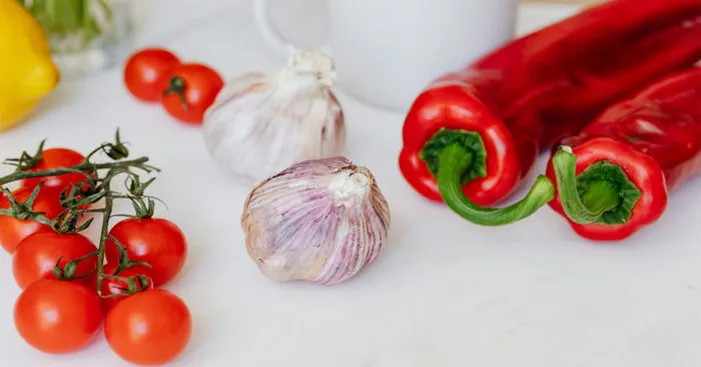
Compared to traditional garlic, red garlic has a milder flavor and cannot be used in dishes that require strong flavor.
To get a better idea, the taste of red garlic falls between the taste of classic garlic and the taste of onion.
Hence, you can use it pretty much the same way you use onions.
As you can chop or slice it then add it to grilled or smoked food or in salads.
Also, you can include it in other different dishes such as pasta, soups, or pizzas.
Reduce bad breath caused by garlic:
Ever wondered why onions and garlic cause such annoying bad breath?
This is due to the existence of Allicin, a compound released when you chop onions or garlic. (24)
Ironically, this same compound is responsible for many of the garlic benefits.
In order to avoid bad breath, make sure you clean your teeth thoroughly.
Since some compounds in garlic are sticky, don’t forget to clean the surface of the tongue.
Some people also recommend eating apples, mint, drink orange juice or chew on some parsley. (25)
These foods have the ability to neutralize bad breath in general and red garlic smell more specifically.
Precautions before consuming garlic:

Despite the many virtues of garlic, they can still be harmful to a certain group of people.
People with the following conditions should stay away from garlic: (26)
Bleeding disorders:
Patients who are dealing with one of the bleeding disorders should not consume garlic.
This is because garlic can increase the risk of bleeding.
It is the same reason why you shouldn’t eat garlic two weeks prior to surgery to avoid bleeding.
Digestive problems:
Just like we mentioned above, garlic is among the allium family which has medicinal properties to ensure gut health.
However, sometimes they can cause irritation and inflammation of the digestive system especially for those who already deal with stomach problems.
Diabetes:
As mentioned above, as part of the many benefits of garlic it can reduce the blood sugar level.
Even though this is beneficial most of the time, it can cause problems for diabetic patients.
Low blood pressure:
Just like its ability to lower blood sugar levels, garlic can significantly reduce blood pressure.
This is very beneficial for hypertensive people, but can cause complications for people who have a hypotension.
Pregnancy and children:
According to many pieces of research, garlic may interfere with certain medications women take during pregnancy. (27)
This can cause unexpected complications and may harm the mother or the fetus especially during the first period of pregnancy.
As for children, it is not recommended to consume large doses of garlic and they should avoid putting it on their skin.
Buying garlic:
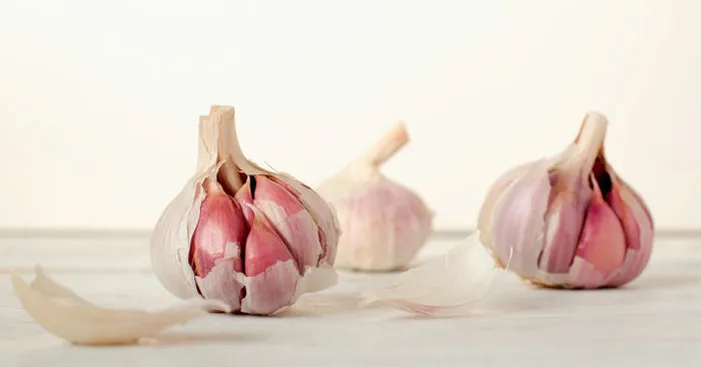
Selecting good and fresh garlic to buy is probably easier than choosing any other vegetable.
- Squeeze the bulb in your hand to judge the firmness of the cloves.
- Examine the head of the garlic and make sure it is plump.
- If you notice green sprouts sticking out of the clove, the garlic is more suited for planting and not for eating.
Storing red garlic?
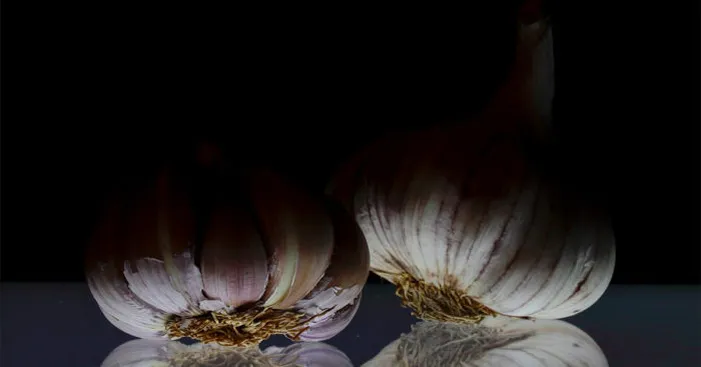
Although vegetables usually have a short lifespan, this is not the case for red garlic.
The allium family vegetables such as onions, leek and garlic are much more resistant to spoiling.
Russian red garlic doesn’t do well in a humid or hot place, which is why it’s better to store them in a cool and dry places.
In fact, exposing them to high humidity or heat will spoil them and make the cloves become soft.
The red garlic should not be in contact with water (like night humidity) but a temperate room with average humidity is perfect.
This is because excessive lack of humidity in the air will cause the garlic to dry out.
On the other hand, lack of air and ventilation causes mold to form.
Based on that, the most common right places people use to store garlic are either in the closet or in a dark storage room.
Some experts recommend storing garlic in the refrigerator, but not in a sealed bag so it doesn’t save moisture.
As for cooking tips, red garlic is used like any other type of garlic by peeling the thin skin and eating it cooked or raw.
References:
(1): Allium Vegetables and Risk of Prostate Cancer: A Population-Based Study | JNCI: Journal of the National Cancer Institute | Oxford Academic (oup.com)
(2): Allicin, the Odor of Freshly Crushed Garlic: A Review of Recent Progress in Understanding Allicin’s Effects on Cells – PMC (nih.gov)
(3): Mother Nature | Garlic (mother-nature.ca)
(4): Chesnok Red – Sweet N’ Savory Garlic Farm (sweetnsavorygarlicfarm.com)
(5): What Is Russian Garlic? (sfgate.com)
(6): Difference Between Article Garlic and Purple Garlic | Difference Between
(7): Russian Red Garlic Variety – SeedWise – SeedWise.com
(8): Properties and Benefits of Red Garlic – NatureWord
(9): Red Russian Garlic – West Coast Seeds
(10): Elephant Garlic: Nutrition Facts, Storage, Eat, Roasted Recipe, Where to Buy – TexasRealFood
(11): Athlete’s foot – Symptoms and causes – Mayo Clinic
(12): Garlic in dermatology – PMC (nih.gov)
(13): Garlic (stanfordchildrens.org)
(14): Involvement of adenosine and standardization of aqueous extract of garlic (Allium sativum Linn.) on cardioprotective and cardiodepressant properties in ischemic preconditioning and myocardial ischemia-reperfusion induced cardiac injury – PMC (nih.gov)
(15): WHO EMRO | Review: Effect of garlic on atherosclerosis and its factors | Volume 14, issue 1 | EMHJ volume 14, 2008
(16): Garlic and Cardiovascular Disease: A Critical Review | The Journal of Nutrition | Oxford Academic (oup.com)
(17): Organosulfur compounds and possible mechanism of garlic in cancer – ScienceDirect
(18): Experimental Biology 2019 (core-apps.com)
(19): Investigating the Gut Microbiota Modulation Effects of Allicin for Cardiovascular Disease Protection and Establishing Microbiota Directed Personalized Nutrition Guidance With Novel Humanized Gnotobiotic Mice Model, Microbial Culturomics and Metabolomic Technique – Full Text View – ClinicalTrials.gov
(20): Flavylium | C15H11O+ – PubChem (nih.gov)
(21): Anthocyanins benefits and traditional uses.
(22): The Top 8 Health Benefits of Garlic – Spice World (spiceworldinc.com)
(23): Osteoporosis – NHS (www.nhs.uk)
(24): Allicin: Benefits, Side Effects, Dosage, and Interactions (verywellhealth.com)
(25): Garlic Breath? Science Says Eat an Apple | CFAES (osu.edu)
(26): 14 Serious Side Effects Of Garlic (Foods To Avoid With It) (stylecraze.com)
(27): Garlic as Hypertension Drug during Pregnancy Endangers Fetus | Universitas Gadjah Mada (ugm.ac.id)
(28):

